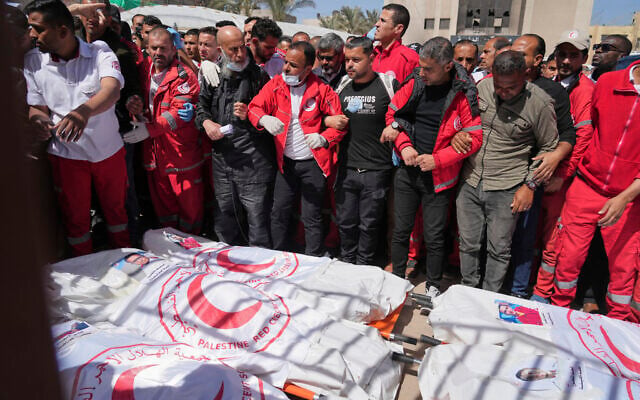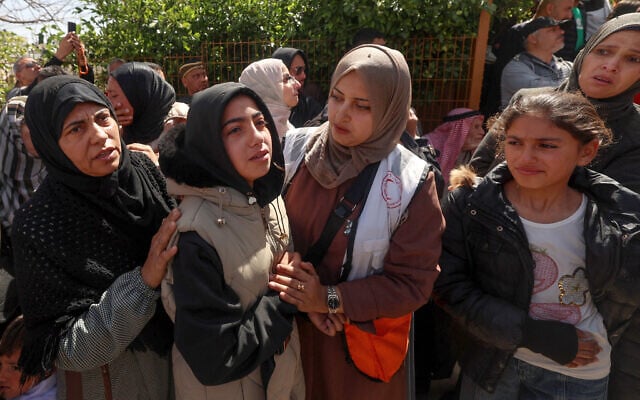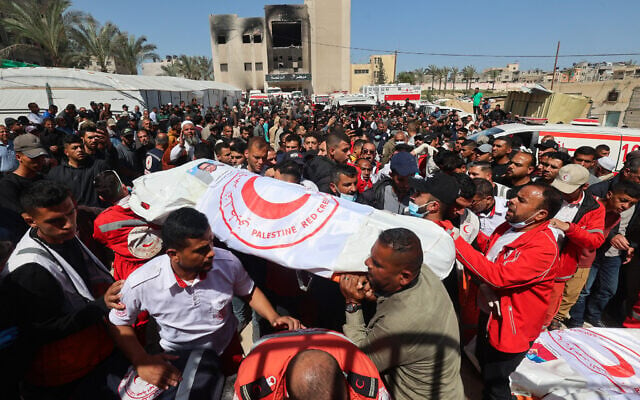IDF shares initial details from Gaza ambulance probe, says troops told UN of burial site
Military says it’s looking into discrepancy between soldiers’ account and video from medic’s phone, but asserts forces didn’t try to hide incident, denies any executions took place

The Israel Defense Forces acknowledged on Saturday evening that it had been incorrect in its initial account of an incident in southern Gaza’s Rafah last month during which troops fired on Palestinian emergency vehicles, killing 14 or 15 medics whose bodies were later recovered from a mass grave.
On Saturday, the army detailed the initial findings from its investigation of the incident, which it said was ongoing. It asserted that at least six of those killed had been posthumously identified as Hamas operatives, denied that any of those killed had been executed, and said troops had not attempted to hide the incident but rather had informed the UN of the location of the grave.
After the incident came to light, the military, which accuses Hamas of embedding itself in civilian infrastructure, had initially said the vehicles were without headlights or emergency lights, were uncoordinated, and arrived on the scene shortly after a group of terror operatives. As such, the IDF said soldiers deemed them “suspicious” and opened fire.
On Saturday, however, The New York Times published a video that appeared to show the emergency vehicles were clearly marked and had their emergency lights on when the IDF opened fire.
UN officials have said that 15 medics were killed by Israeli fire, while the military said that 14 people were killed and one survived.
Palestinians have accused Israeli forces of attempting to cover up the incident by burying the bodies in a mass grave. Claims have also emerged that some of the bodies had their hands tied and were seemingly shot dead from close range.
Following the emergence of the video Saturday, the military said that Southern Command chief Maj. Gen. Yaniv Asor would be re-investigating the incident. The complete findings will be presented to IDF Chief of Staff Lt. Gen. Eyal Zamir on Sunday.
Findings to be handed to IDF chief
According to the military’s findings, the incident began on March 23 amid the resumption of fighting in Gaza, and a new offensive in Rafah’s Tel Sultan neighborhood.
Golani soldiers, who were operating under the 14th Armored Brigade, had set up an ambush on a road in Tel Sultan at around 4 a.m. At that time, the military said, several ambulances and civilians passed by without incident.
At around 4:30 a.m., a Hamas police vehicle drove through the area, and the Golani soldiers exchanged fire with the operatives inside, killing one and capturing two others, the IDF said. The Hamas vehicle remained on the side of the road.
At around 6 a.m., a convoy of ambulances arrived in the area, and the IDF soldiers opened fire, perceiving them as a threat. Drone operators flying a UAV overhead had reported to the Golani soldiers that the vehicles were moving toward them in a suspicious manner.

The initial investigation claimed that the soldiers were surprised by the convoy stopping on the road, next to the abandoned Hamas vehicle, and by several “suspects” jumping out of the convoy and running. The soldiers were said to have been unaware that the suspects were, in fact, unarmed medics.
The IDF acknowledged that based on the video, its initial statement asserting that the ambulances had had their lights off appeared to be incorrect, noting that it was based on the testimony of soldiers involved in the incident.
The new IDF investigation is examining that discrepancy.
The military also said that at least six of the bodies were identified by intelligence officials as Hamas operatives. It was expected to detail the names of the six operatives once the probe was concluded.

The initial findings rejected claims that the soldiers had intentionally targeted the medics from close range, carried out executions, or tied up the hands of any of the medics.
Informing the UN
The IDF also rejected the assertion that troops had buried the bodies in an unmarked mass grave without informing anyone.
Palestinian Red Crescent chief Dr. Younis Al-Khatib had said on Friday that the aid workers were “targeted from a very close range” and that Israel had “kept us for eight days in the dark” as to the whereabouts of the bodies.
According to the military’s initial probe, a deputy battalion commander in Golani and his troops collected the bodies in one spot, covered them with sand, and marked the burial spot.
The army said that burying bodies in this way was an approved and regular practice during fighting in Gaza, to prevent wild dogs and other animals from eating the corpses.
The United Nations was promptly notified of the burial spot, the IDF said, and was told to come and collect the bodies. The following day, however, the UN was unable to find the location, and the forces were unavailable to assist as they were busy with another task.
The UN was then called to return several days later to collect the bodies, and the bodies were eventually recovered in coordination with the IDF, the initial military probe found.
The UN has said that the mangled ambulances were found buried alongside the bodies. According to the IDF probe, an armored D9 bulldozer pushed the ambulances off the road to open it up, crushing the vehicles in the process.
Officials from the Palestinian Red Crescent have said that they will submit the video of the attack, filmed on the phone of one of the slain medics, to the UN Security Council.
The IDF first acknowledged that it had fired on the ambulances and fire engine on March 28, five days after the incident occurred.
The bodies of the medics, who worked for the Red Crescent, the United Nations, and the Hamas-linked Palestinian Civil Defense, were recovered from the mass grave on April 1.

The International Federation of Red Cross and Red Crescent Societies said that the incident was the single most deadly attack on Red Cross or Red Crescent workers anywhere since 2017.
According to the United Nations, at least 1,060 healthcare workers have been killed in the 18 months since Israel launched its offensive in Gaza in response to Hamas’s October 7 onslaught, during which some 1,200 people were killed, and roughly 250 were taken hostage by terrorists.
The IDF says that Hamas operatives regularly operate from within medical facilities.
The incident in the Tel Sultan neighborhood came five days after Israel restarted intense bombing of Gaza on March 18 and then launched a new ground offensive, shattering a nearly two-month ceasefire in the war with Hamas.
According to the terms of the January 19 ceasefire deal, the sides were to launch negotiations over the second phase a few weeks into the first, but Prime Minister Benjamin Netanyahu refused to do so, insisting that the war would not end until Hamas’s governing and military capabilities had been demolished. Meanwhile, Hamas rejected a series of offers to extend the first phase while continuing to free hostages gradually.
No comments:
Post a Comment